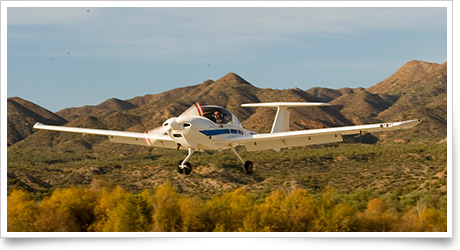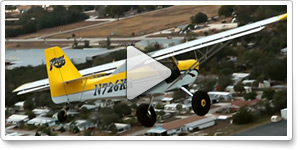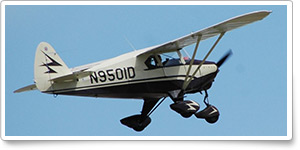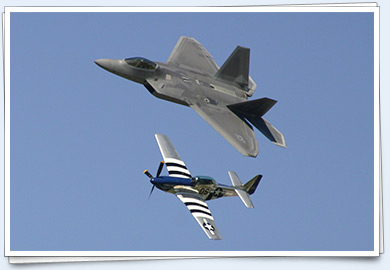| ||||||
| ‘Full-stall’ landings |
| |||||
Training Tips‘Full-stall’ landings A full-stall landing—simply a “normal landing”—employs a power-off stall to complete a touchdown that occurs smoothly as the aircraft is decelerated to approximately V SO. While flaring to land, the pilot adds sufficient back-pressure to maintain a gradually decreasing descent rate, which just before touchdown is almost nil, allowing the aircraft to gently contact the runway. Maintaining back-pressure once the wheels are rolling lets aerodynamic braking assist deceleration to taxi speed. A common error is adding so much back-pressure that the descent stops too high above the runway, or the trainer balloons upward—in either case possibly leading to a hard landing. Lowering the angle of attack, and simultaneously adding power to cushion the touchdown, or going around—is the remedy. Another common error is the pilot being unwilling to flare aggressively enough to manage the descent, resulting in premature touchdown in a nose-low attitude, a bounce, or in extreme cases, porpoising—a worsening series of hard touchdowns causing many landing mishaps. You can banish those problems from your landing technique by heading back to the practice area and performing some power-off stalls, using a predetermined altitude as an imaginary runway in the sky. Starting, say, 100 feet higher than the selected altitude, descend in the landing configuration. As the altitude is approached, idle the power and flare as required to keep the aircraft from descending any lower until the stall occurs. Recover as usual for power-off stalls as provided in the practical test standards. During the maneuver, note the gradual nature and extent of the up-elevator force you must apply, and when any pre-stall buffeting occurs. Be smooth but assertive with control inputs, making sure to use enough back-pressure to keep from contacting your “runway.” This may take full back-elevator. Maintain direction with rudder (as you would in an actual landing). Returning to the traffic pattern for landings, feel more confident about timing your flare and applying control pressures needed to execute a proper full-stall landing. Be sure to review the Air Safety Institute’s Takeoffs and Landings Safety Advisor for additional insights. Flight Training NewsArizona student receives AOPA scholarshipArizona student pilot Theresa Farley soloed just after her sixteenth birthday, and then had to set aside her dream of becoming a pilot for many years. Now a married mother of two, she received a $3,000 scholarship from AOPA that she hopes will get her well on the way to that goal. Read more >> EAA works to boost ranks of female pilotsThe Experimental Aircraft Association’s Young Eagles program has helped to create 18,800 certificated pilots, EAA President Rod Hightower said March 10 at the International Women in Aviation Conference in Dallas. Of those, just more than 9 percent are women. The association has other initiatives aimed at attracting more young women to aviation, including a summer camp and a mentoring program that coincides with EAA AirVenture in Oshkosh, Wis. Read more >> Flight school management system debutsMyFlightTrain, a flight school management system, debuted last week at the International Women in Aviation Conference in Dallas. The Web-based system enables Part 61 and Part 141 schools to use paperless tracking, among other features. The developer, Flying Software Labs, also unveiled a new pilot social network, MyFlightTrack. Read more >> Avia announces accelerated instrument rating programAvia IFR Training Centers in Palm Coast, Fla., has unveiled a new accelerated instrument rating program. The program utilizes advanced flight simulation devices, aircraft equipped with glass-cockpit avionics, aircraft with analog gauges, and a proprietary curriculum that focuses on real-world experience, the company said. Students hone skills in a simulator before moving to aircraft, and both simulator and aircraft are equipped with video recorders. For more information, see the website. Training ResourcesSatellite navigation is used in numerous applications—in the air and on the ground. But do you know the important stuff that affects its use in flight? How do WAAS or RAIM enter in? When should you create user waypoints? Do you need updated databases to be legal for VFR flight? If you're using “direct to” instead of activating a flight plan, consider the Air Safety Institute’s GPS for VFR Operations course to extract everything you can from the GPS box on your next flight. Course completion qualifies for AOPA Accident Forgiveness and FAA Wings.
Did you know that student pilots who join AOPA are three times more likely to complete their flight training? Membership includes unlimited access to aviation information by phone (800/USA-AOPA, weekdays from 8:30 a.m. to 6 p.m. Eastern time) or from Flight Training Online or AOPA Online. If you're not already a member, join today and get the pilot’s edge. Login information is available online. Kitfox light sport aircraft Career PilotAttracting talented workforce will be aviation’s challengeOver the next 20 years, the aviation industry will need more than 1 million pilots and aircraft technicians to fly and maintain the aircraft needed to support commercial air travel growth, a Boeing representative said March 10 at the International Women in Aviation Conference in Dallas. Boeing trains 50,000 pilots and technicians per year across 20 training campuses around the world. Read more >> Alaska Air Group declares stock splitAlaska Air Group announced Feb. 16 that its board of directors has declared a two-for-one stock split that will be implemented as a stock dividend. The additional shares will be distributed on March 16 to shareholders of record on March 2. The stock split will increase Alaska Air Group’s outstanding shares from approximately 35.5 million to about 71 million shares. However, the board also approved a stock repurchase program authorizing the company to buy up to $50 million of its common stock over the next year. The company said it would finance the stock repurchases with cash on hand. Plane SpotterPiper Tri-Pacer: Wings on the top Training ProductsSporty’s Learn to Fly CourseSporty’s has revamped its popular learn-to-fly course from the ground up. The course now can be used by those training for the sport, private, or recreational pilot certificate, and you can choose from three formats— DVD, online, or iOS app for the iPhone/iPad—for one price. The course includes video footage and 3-D animations, a practical test standards study guide cross-referenced for the video, a training course outline, and a test endorsement for the knowledge test. Each course is priced at $249. Order online or call 800/776-7897.
Note: Products listed have not been evaluated by ePilot editors unless otherwise noted. AOPA assumes no responsibility for products or services listed or for claims or actions by manufacturers or vendors. Member BenefitsEmergency Assistance Plus not just for dire emergenciesWhen you’re away from home, anything that disrupts travel can be an emergency. You don’t have to be critically ill to take advantage of the many benefits of Emergency Assistance Plus (EA+). The program comes to the rescue for serious medical situations and death while away from home, but it also helps with minor yet annoying travel disruptions. Read more >> Snoring can be a symptom of other conditionsDo you snore? Snoring can be a symptom of a more serious condition known as obstructive sleep apnea, in which the partial blocking of an airway leads to snoring, disturbed sleep, and daytime fatigue. And that fatigue is a source of concern to pilots and air traffic controllers because of the increased potential for accidents. Read more >> BlogsStudent pilot is a ‘Shining Star’You just never know who shares your passion for aviation, as Flight Training Technical Editor Jill W. Tallman discovered last week at an aviation conference. Also in the Flight Training blog, Chip Wright observes that tourists from other countries offer lessons in culture and behavior for everyone. Bucket lists, new adventuresSharing our wonderful aviation experiences with others is part of a pilot’s responsibility. And so AOPA eMedia Managing Editor Alyssa J. Miller spent a busy afternoon giving flights to girls and women who had never been in a small airplane. She describes their excitement in the Reporting Points blog. AOPA Career OpportunitiesEver dream of turning your passion for aviation into a career? We’re looking for a project manager of online products, aviation technical specialist, member services representative, manager of regulatory affairs, director of new market development, associate project manager, online product manager, marketing specialist–products, aviation education program developer, accounting manager, and associate editor–Web/ ePilot. To learn more about other AOPA career opportunities, visit AOPA Online. Community
AVIATION EVENTS & WEATHER
| ||||||||||||||||||||||||||||||||||||




 Stalls aren’t everybody’s cup of tea. Exploring stalls at the margins to seek out their aerodynamic tip-offs makes them more user friendly. Although emphasis in training is on recognizing and avoiding loss-of-control stalls—especially at low altitude—one brand of stall is essential for making a good landing.
Stalls aren’t everybody’s cup of tea. Exploring stalls at the margins to seek out their aerodynamic tip-offs makes them more user friendly. Although emphasis in training is on recognizing and avoiding loss-of-control stalls—especially at low altitude—one brand of stall is essential for making a good landing.




